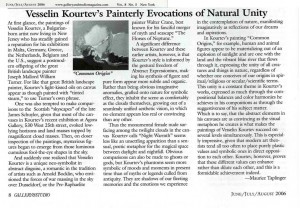GALLERY&STUDIO, June/July/August 2006, Vol. 8
Vesselin Kourtev’s Painterly Evocations of Natural Unity
 At first glance, the paintings of Vesselin Kourtev, a Bulgarian-born artist now living in New Jersey who has steadily gained a reputation for his exhibitions in Malta, Germany, Greece, the Netherlands, Belgium and the U.S., suggest a postmodern offspring of the great British landscape painter Joseph Mallord William Turner. For like that great British landscape painter, Kourtev’s light-kissed oils on canvas appear as though painted with “tinted steam,” to use Turner’s own phrase.
At first glance, the paintings of Vesselin Kourtev, a Bulgarian-born artist now living in New Jersey who has steadily gained a reputation for his exhibitions in Malta, Germany, Greece, the Netherlands, Belgium and the U.S., suggest a postmodern offspring of the great British landscape painter Joseph Mallord William Turner. For like that great British landscape painter, Kourtev’s light-kissed oils on canvas appear as though painted with “tinted steam,” to use Turner’s own phrase.
One was also tempted to make comparisons to the Scottish “skyscapes” of the late James Schuyler, given that most of the canvases in Kourtev’s recent exhibition at Agora Gallery, 530 West 25th street, evoked low-lying horizons and land masses topped by magnificent cloud masses. Then, on closer inspection of the paintings, mysterious figures began to emerge from those luminous cumulous fool-the-eye shapes in the sky.
And suddenly one realized that Vesselin Kourtev is a unique neo-symbolist in abstract disguise, a romantic in the tradition of artists such as Arnold Bocklin, who envisioned the forces of war massing in the sky over Dusseldorf, or the Pre-Raphaelite painter Walter Crane, best known for his fanciful merger of myth and seascape “The Horses of Neptune.”
A significant difference between Kourtev and these earlier artists, however, is that Kourtev’s style is informed by the gestural freedom of Abstract Expressionism, making his synthesis of figure and pure form appear more subtle and organic. Rather than being obvious imaginative anomalies, grafted onto nature for symbolic effect, they inhabit the scene as comfortably as the clouds themselves, growing out of a seamlessly unified aesthetic vision, in which no element appears less real or convincing than any other.
 Thus the monumental female nude surfacing among the twilight clouds in the canvas Kourtev calls “Night Warmth” seems less like an unsettling apparition than a sensual, poetic metaphor for the magical space between daylight and nightfall. Obvious comparisons can also be made to ghosts or gods, but Kourtev’s phantoms seem more symbolic of moods and moments in present time than of myths or legends culled from antiquity. They are shadows of our fleeting memories and the emotions we experience in the contemplation of nature, manifesting imaginatively as reflections of our dreams and aspirations.
Thus the monumental female nude surfacing among the twilight clouds in the canvas Kourtev calls “Night Warmth” seems less like an unsettling apparition than a sensual, poetic metaphor for the magical space between daylight and nightfall. Obvious comparisons can also be made to ghosts or gods, but Kourtev’s phantoms seem more symbolic of moods and moments in present time than of myths or legends culled from antiquity. They are shadows of our fleeting memories and the emotions we experience in the contemplation of nature, manifesting imaginatively as reflections of our dreams and aspirations.
In Kourtev’s painting “Common Origins,” for example, human and animal figures appear to be materializing out of an explosion of sunlight and are one with the land and the vibrant blue river that flows through it, expressing the unity of all creatures and things in nature, regardless of whether one conceives of our origins in spiritual/religious or secular/scientific terms. This unity is a constant theme in Kourtev’s works, expressed as much through the compositional balances and color harmonies he achieves in his compositions as through the suggestiveness of his subject matter. Which is to say, that the abstract elements in his canvases are as convincing as the visual metaphors he creates is what makes the paintings of Vesselin Kourtev succeed on several levels simultaneously. This is especially impressive, given that modern art theorists tend all too often to place purely plastic values and symbolic ones in direct opposition to each other. Kourtev, however, proves that these different values can enhance rather than dilute each other, and this is a formidable achievement indeed.
Maurice Taplinger
GALLERY&STUDIO, June/July/August 2006, Vol. 8, No. 5, New York



